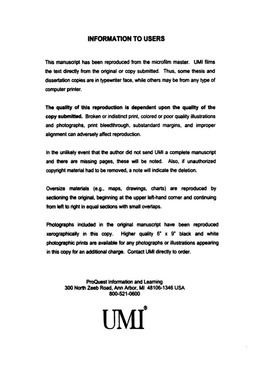| dc.contributor.advisor | Gan, Rong Zhu, | en_US |
| dc.contributor.advisor | Chang, Kuang-Hua, | en_US |
| dc.contributor.author | Sun, Qunli. | en_US |
| dc.date.accessioned | 2013-08-16T12:18:24Z | |
| dc.date.available | 2013-08-16T12:18:24Z | |
| dc.date.issued | 2001 | en_US |
| dc.identifier.uri | https://hdl.handle.net/11244/379 | |
| dc.description.abstract | The work reported in this dissertation is the result of a joint venture of biomedical scientists and engineers for understanding human middle ear mechanics through finite element modeling and analysis. The main objective of the research is to explore the middle ear dynamics by using an accurate finite element model of the human middle ear. | en_US |
| dc.description.abstract | The base-line finite element model was employed for three preliminary clinical applications. The results suggest that the base-line finite element model is very useful in the study of the middle ear mechanics, and the design and test of implantable hearing devices. | en_US |
| dc.description.abstract | The research started with developing a systematic and accurate geometric modeling method that can be employed to reconstruct the middle ear from the histological sections of a human temporal bone in the Computer-Aided Design (CAD) environment. Using the method, a solid model of human middle ear was constructed which reveals excellent accuracy in geometry. | en_US |
| dc.description.abstract | Then a finite element model of the human middle ear was built by using the geometry translated from the CAD model and the published material properties of the middle ear system. The finite element model was finalized as the base-line finite element model by adjusting physical parameters based on the stapes footplate displacements obtained by laser Doppler interferometry measurements. Finally, the accuracy of the base-line finite element model was verified by using four sets of published experimental measurements. These verifications demonstrate that the base-line model constructed using the geometric modeling method developed in this research is adequate in predicting the dynamic behaviors of the middle ear. Therefore, it is appropriate to employ the finite element model to simulate the middle ear frequency response characteristics, which are the main concerns in the middle ear sound transmission study. | en_US |
| dc.format.extent | xv, 146 leaves : | en_US |
| dc.subject | Engineering, Mechanical. | en_US |
| dc.subject | Middle ear. | en_US |
| dc.subject | Computer-aided design. | en_US |
| dc.subject | Engineering, Biomedical. | en_US |
| dc.subject | Finite element method. | en_US |
| dc.title | Computer-integrated finite element modeling and simulation of human middle ear. | en_US |
| dc.type | Thesis | en_US |
| dc.thesis.degree | Ph.D. | en_US |
| dc.thesis.degreeDiscipline | School of Aerospace and Mechanical Engineering | en_US |
| dc.note | Advisers: Kuang-Hua Chang; Rong Zhu Gan. | en_US |
| dc.note | Source: Dissertation Abstracts International, Volume: 62-10, Section: B, page: 4752. | en_US |
| ou.identifier | (UMI)AAI3028807 | en_US |
| ou.group | College of Engineering::School of Aerospace and Mechanical Engineering | |
